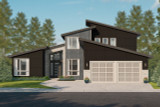Take the First Step Towards Your Dream Home or Garage! Shop Now for Pre-Designed Plans.
Choosing Your Dream Home Blueprint: Stock Plans vs. Custom Designs – What's Right for You?

In the intricate world of residential home design, the pivotal decision between utilizing a stock plan or embarking on a custom design journey is one that resonates deeply with both designers and homeowners alike. Each path presents a distinct array of advantages and drawbacks, profoundly influencing the trajectory and outcome of a project. As custodians of spatial aesthetics and functionality, residential home designers bear the responsibility of navigating this terrain with precision, understanding the nuanced interplay between preconceived templates and bespoke creations. In this discourse, we delve into the heart of this debate, dissecting the contrasting facets of stock plans and custom designs from the discerning lens of a residential home designer.
Stock plans, also referred to as pre-designed or ready-made blueprints, represent a pragmatic solution crafted by architects and designers to cater to the diverse array of homeowners' needs and aspirations. These pre-existing designs offer a mosaic of styles and sizes, intricately woven to accommodate various preferences and spatial requirements. For the budget-conscious homeowner seeking a blueprint that marries affordability with functionality, stock plans emerge as an enticing prospect. Their accessibility and cost-effectiveness present an avenue for realizing the dream of homeownership without traversing the labyrinth of custom design intricacies. However, nestled within the allure of stock plans lies a dichotomy — a trade-off between convenience and personalization.
Stock Plans, Pre-Designed Floor Plans, and Ready-Made Blueprints:
Stock plans, also known as pre-designed or ready-made plans, are predesigned blueprints created by architects or designers. These plans are readily available for purchase and typically come in a variety of styles and sizes to accommodate different preferences and needs. Here are some of the pros and cons of starting with a stock home, garage, and duplex plans:
Pros of Stock House Plans:
- Cost-Effectiveness: One of the most significant advantages of stock plans is their affordability. Since these designs are pre-made and sold multiple times, the cost is significantly lower compared to custom designs, making them an attractive option for budget-conscious clients.
- Time Efficiency: Stock plans can save a considerable amount of time in the design phase. Instead of starting from scratch, designers can select a pre-existing plan that closely matches the client's requirements, thereby streamlining the process and reducing the time needed for revisions.
- Tested Designs: Stock plans are often based on proven designs that have been tested and optimized for functionality and efficiency. This can provide clients with peace of mind knowing that the design has already been implemented successfully in other projects.
- Flexibility: While stock plans are pre-designed, they still offer a degree of flexibility. Designers can often make minor modifications to customize the plan to better suit the client's preferences or accommodate specific site conditions without the need for a complete redesign.
Cons of Ready-Made Floor Plans:
- Lack of Originality: Since stock plans are mass-produced designs, they lack the uniqueness and personalized touch that comes with a custom design. Clients who prioritize individuality and exclusivity may find stock plans unsatisfactory.
- Limited Customization: While minor modifications are possible, stock plans have limitations in terms of customization. Clients with specific or unconventional requirements may find it challenging to adapt a stock plan to meet their needs adequately.
- Potential for Compromise: Clients may need to compromise on certain aspects of the design to fit within the constraints of a stock plan. This could include sacrificing certain features or adjusting room layouts to align with the pre-existing design.
- Site Compatibility: Stock plans are not tailored to the unique characteristics of a particular site. Clients must ensure that the chosen plan is compatible with their building site in terms of topography, orientation, and local building codes.
Custom Home Designs:
Custom designs involve creating a unique blueprint tailored to the specific requirements and preferences of the client. Unlike stock plans, custom designs are crafted from scratch, offering unparalleled flexibility and personalization. Let's explore the pros and cons of opting for a custom design:
Pros of Custom Home Designs:
- Unlimited Creativity: Custom designs provide endless opportunities for creativity and innovation. Designers can work closely with clients to translate their vision into a one-of-a-kind masterpiece that reflects their personality, lifestyle, and aesthetic preferences.
- Tailored to Site: Unlike stock plans, custom designs can be tailored to the unique characteristics of the building site. This includes optimizing the layout to maximize views, natural light, and energy efficiency while addressing site-specific challenges.
- Personalization: Custom designs allow for a high level of personalization, enabling clients to customize every aspect of their home according to their individual needs and desires. From floor plans to finishes, every detail can be customized to create a truly bespoke living space.
- Long-Term Satisfaction: Since custom designs are tailored to the client's specific requirements, they are more likely to result in long-term satisfaction and enjoyment. Clients can rest assured knowing that their home is designed precisely to their liking, minimizing the need for future renovations or modifications.
Cons of Custom Plans:
- Higher Costs: The primary drawback of custom designs is the higher cost associated with bespoke services. Designing a home from scratch requires extensive time and expertise, resulting in higher design fees and construction costs compared to stock plans.
- Extended Timeline: Custom designs typically involve a more prolonged design process, as every aspect of the home must be carefully considered and refined to meet the client's expectations. This can extend the overall timeline of the project, delaying construction and occupancy.
- Complexity: Custom designs can be more complex to execute. Intricacies of a custom design may pose challenges during construction and require a seasoned team of design and build professionals.
As your dedicated residential home designer, the weight of the decision before you is palpable: to embark on the journey with a stock plan or to craft a bespoke design tailored to your vision and lifestyle. It's a choice that hinges not only on practicalities but also on the desire to create a space that feels unequivocally yours—a sanctuary that resonates with your essence and aspirations.
Throughout this discourse, we've traversed the intricate tapestry of stock plans and custom designs, weighing their respective merits and considerations. Whether you're drawn to the cost-effectiveness and proven functionality of stock plans or considering the added investment for a custom design, the decision ultimately rests on factors such as budget, timeframe, and whether a bespoke floor plan aligns with your immediate needs. Rest assured, whichever path you choose, guidance will be provided every step of the way, ensuring that your home reflects not just a structure, but a manifestation of your dreams and identity. As you stand at this crossroads, know that the decision lies in your hands, leading to a home that embodies your unique story—one that unfolds with beauty, functionality, and unwavering satisfaction regardless of the design path taken.

